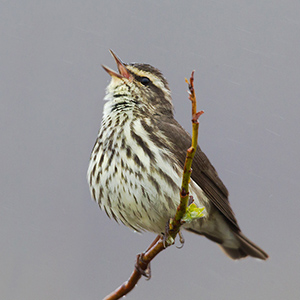Monitoring Temporal Trends of Mercury in Songbirds of New York State
Changes are coming to the landscape of mercury contamination in the northeastern United States. New rules put in place by the Environmental Protection Agency combined with the changes to our energy production portfolio in the United States and around the world will be determining factors regarding mercury emissions and deposition in the United States. Whether these changes lead to reductions of mercury in wildlife and ecosystems remains unclear. Because mercury, a potent neurotoxin, can persist in the environment for an extended period of time, BRI’s research will contribute valuable information in determining the extent to which atmospheric emissions are a primary factor affecting the availability of mercury to wildlife.
Related Publications
Project Goals

In collaboration with The Nature Conservancy, BRI has begun a five-year project using songbirds as indicators of ecosystem mercury levels throughout the State of New York. In response to previous research that has demonstrated the adverse impacts of mercury on songbird behavior, reproduction, and survival, it is critical that we continue to improve our understanding of the connections between mercury availability, environmental factors, and the ecology of avian species.
Project Components

This long-term study is designed to evaluate how mercury levels are changing over time in a variety of locations and habitats, so that we can assess whether the impacts of recent changes in mercury emissions policy will lead to improvements in ecological health and integrity across New York State.
The specific objectives of this project include:
- Monitoring long-term annual trends in mercury levels at core sites of known high mercury levels or highly sensitive habitats
- Assessing statewide mercury levels using spatially dispersed and temporally sporadic sampling to identify new biological merury hotspots and aid in spatially explicit mercury availability modeling
- Compare current mercury levels to historic samples and New York State Breeding Bird Atlas to determine long-term changes over time and assess populations that are at greatest risk for mercury exposure
Project Collaborators & Funding
Collaborators
- The Nature Conservancy
- Syracuse University
- U.S. Geological Survey
- National Atmospheric Deposition Program
- New York State Department of Environmental Conservation, Division of Air Resources
- New York State Department of Environmental Conservation, Wildlife Diversity Unit
- Cornell University
- Harvard Museum of Comparative Zoology
- American Museum of Natural History
- Clarkson University
- Albany Pine Bush Preserve
Funding
photo credits: Northern Waterthrush © Ken Archer; Wren © IStock


